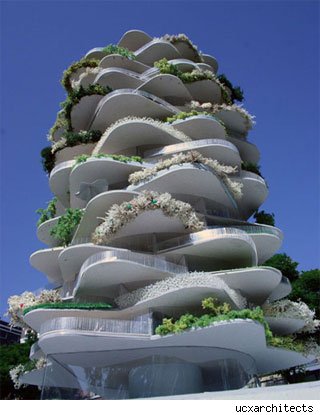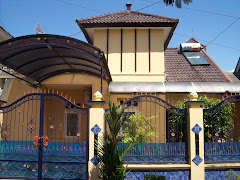
Selasa, 18 Januari 2011
Aceh House / Rumoh Aceh - Indonesia
Diposkan oleh Aceh on 8 Apr 2010




Rumoh Aceh Aceh is a traditional house. Rumoh Aceh-type house on stilts with 3 main parts and an additional section. Three main parts of Aceh is home Seuramoe keuë (front porch), Seuramoe Teungoh (porch middle) and Seuramoe likôt (back porch). Meanwhile, an additional section that is rumoh dapu (home kitchen).
Rumoh Aceh can be seen directly in the Museum District in the city of Banda Aceh which was made in 1914 to Exhibition Venues in Semarang, Central Java. Then taken home to Banda Aceh in 1915 by Governor Van Swart (Netherlands), which is then converted into a museum so far. This building houses on stilts which form a narrow door, but inside the room is not insulated.
With the outside view black diseling brightly colored ornaments typical of Aceh, the building holds several collections of ceramics and paintings hero Aceh. When entered it will taste a thick atmosphere of tradition. How traditional Acehnese house layout is very pronounced. Starting from the arrangement of meeting rooms, bedrooms, kitchens and furniture storage daily. Of course this will be difficult to find now.
But after the tsunami disaster two years ago, many who adopt this style of house on stilts. Some may think that the tsunami struck again would be much more secure with the type of buildings like this. Sure to be considered a more solid foundation, no longer than a stick. However the wisdom of the past always offers a medium of reflection. To always reflect yourself and keep learning greet each familiar with nature.
Joglo house - Java - Indonesia

Joglo house is mostly owned by those who can afford. This is due to home form joglo require building materials and more expensive than other forms of home. Javanese society in the past assume that joglo home should not be owned by most people, but the house joglo only allowed to house the nobility, the king's palace, and the princes, and people who esteemed or respected by the others alone. Today joglo house used by all levels of society and also for various other functions, such as conference hall and offices.
Many beliefs that cause people is not easy to make a house shape joglo. Houses form joglo besides requiring more materials, also requires a large financing, especially if the house is damaged and needs to be repaired.
Economic life of someone who had also participated in the tidal effect, especially after the shift offspring from parents to children. If the descendants of someone who has a house shape joglo decreased levels of the economy and must improve and must maintain its shape, means it must provide adequate fee. This will be a problem for that person. This is due to the existence of a trust, that changing the shape joglo in another form is forbidden because it would cause a bad influence on his later life, such a wretched, to bring disaster, and so forth.
Basically, the house forms joglo berdenah square. At first, this form has four main pillars in the middle of the call pillars, and is used blandar compound which is called intercropping. This intercropping Blandar layers upward, upward to widen even further. So initially just a central part of the house forms joglo today. Subsequent developments, provided additions to the side parts, so that the pole is added according to need. In addition, a sketch is also changing according to the addition. The changes mentioned there are only a mere extra ordinary, but there also are changes in construction.
From these changes timbulah joglo house forms a wide range with the name of each. Adapaun, the types joglo, among others: joglo jompongan, joglo kepuhan jokes, joglo ceblokan, joglo kepuhan limolasan, joglo sinom clamp, joglo pengrawit, joglo kepuhan clamp, joglo semar tinandu, joglo sexual intercourse, joglo Wantah clamp, joglo hageng , and joglo mangkurat.
Nagoya Castle: Shachihoko Protect Beautiful Nagoya Attractions
Nagoya Castle: Shachihoko Protect Beautiful Nagoya Attractions

When the Japanese cherry blossom trees are in bloom around Nagoya Castle during spring, you can almost forget that it is a reconstruction and imagine what it must have been like almost 400 years ago.

Nagoya-jo was originally constructed in Nagoya, Japan in 1612 but sustained great damage in World War II. In 1959 it was rebuilt from ferro-concrete and its interior now contains a museum about the castle.


However, an interesting feature of Nagano Castle is a pair of male and female gold figures, in the form of a mythical fish with the head of a tiger, which adorn the north and south ends of the roof. These gold ("kin" in Japanese) figures are called Shachihoko and give the castle its nickname of Kinshachi-jo.

Like the umbrella in Chion-in Temple in Kyoto, Shachihoko are believed to protect the castle from fire by bringing the rain.
Other highlights of the castle include:
- Ninomaru Tea House
- Ninomaru Garden
- 600 year old Japanese Nutmeg tree

Opening Hours:
9:00am - 4:30pm (last entry 4:00pm)
Closed:
December 29th - January 1st
Entry:
¥500 Adults
Leave Nagoya Castle and discover more about Japan and Japan Travel.

When the Japanese cherry blossom trees are in bloom around Nagoya Castle during spring, you can almost forget that it is a reconstruction and imagine what it must have been like almost 400 years ago.

Nagoya-jo was originally constructed in Nagoya, Japan in 1612 but sustained great damage in World War II. In 1959 it was rebuilt from ferro-concrete and its interior now contains a museum about the castle.


However, an interesting feature of Nagano Castle is a pair of male and female gold figures, in the form of a mythical fish with the head of a tiger, which adorn the north and south ends of the roof. These gold ("kin" in Japanese) figures are called Shachihoko and give the castle its nickname of Kinshachi-jo.

Like the umbrella in Chion-in Temple in Kyoto, Shachihoko are believed to protect the castle from fire by bringing the rain.
Other highlights of the castle include:
- Ninomaru Tea House
- Ninomaru Garden
- 600 year old Japanese Nutmeg tree

Opening Hours:
9:00am - 4:30pm (last entry 4:00pm)
Closed:
December 29th - January 1st
Entry:
¥500 Adults
Leave Nagoya Castle and discover more about Japan and Japan Travel.
Minggu, 16 Januari 2011
Rumah Antiq dan Unit : Zhang Lianzhi’s Elite Ceramic House @ $65 million - China
Zhang Lianzhi’s Elite Ceramic House @ $65 million Doing away with the custom of having huge villas with green vicinity, the trend is to maintain a small-house with all your precious belongings. Located in Tianjin, northern China, the designer house is clad with 400,000,000 pieces of porcelain, 16000 pieces of antique ceramic, 300 white-marble carvings, and 20 tons of natural crystals. The blessed owner of the house viz. Zhang Lianzhi, a businessman by profession has spent $65 million on decorating the house. The wares carved inside the house were collected by him over the past two decades. The house got furnished lately. News is that after five-years of its decoration, the house will be used for commercial purpose as a restaurant.
di unduh dari : Via Sharingthelife http://www.elitechoice.org/
di unduh dari : Via Sharingthelife http://www.elitechoice.org/
Sabtu, 15 Januari 2011
Rumah Antiq dan Unit
The balconies of the Cactus House apartment building in Rotterdam were designed to maximize outdoor gardening space for tenants.
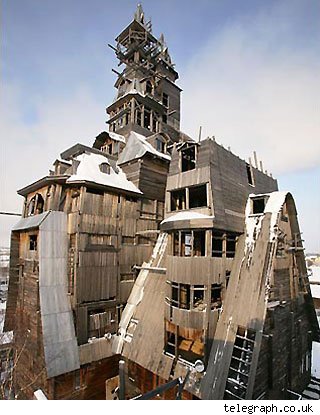
Gangster House – Russia
This soaring wooden tower in Archangelsk, Russia was built by local gangster Nikolai Sutyagin. He never quite got around to finishing its construction – he was jailed before the work was completed.
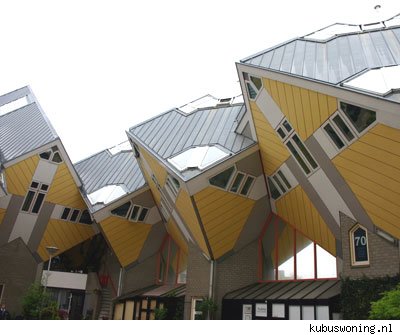
Cube Houses – The Netherlands
The Dutch seem to be building more than their fair share of interesting houses, as evidenced by these “cube houses” in Rotterdam. Architect Piet Blom intentionally tipped the houses 45 degrees on their side. Cutting edge yes, but not good for those with vertigo.
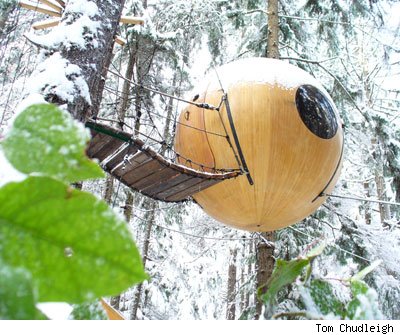
Wooden Sphere House – Canada
The sphere house in British Columbia, Canada takes simplicity to a whole new level. The sphere is anchored to its surroundings using ropes and spiral staircases.
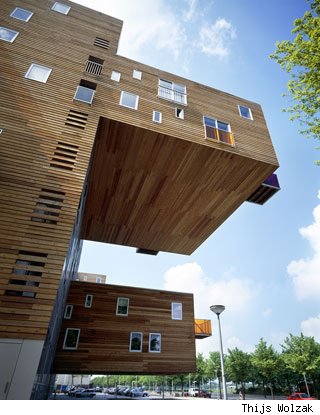
Wozoco Apartments – The Netherlands
This “hanging” apartment building near Amsterdam uses some clever architecture to get around local zoning laws. Dutch laws require sunlight for all units, so the builders simply hung part of the building above the ground allowing for extra square footage and sun for the tenants below.
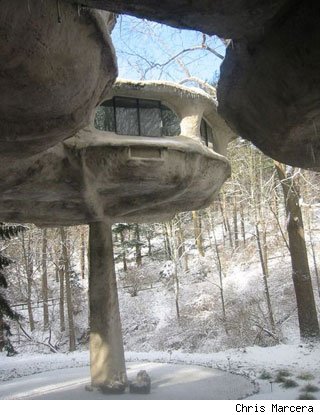
Pod House – New York
Located in New Rochelle, the Pod House’s interesting organic design is based on the structure of a weed called Queen Anne’s Lace.
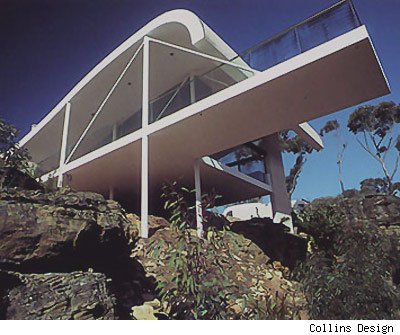
Berman House – Australia
The Berman House in Joadja, Australia hangs over a deep canyon below. I’m sure the views must be spectacular.
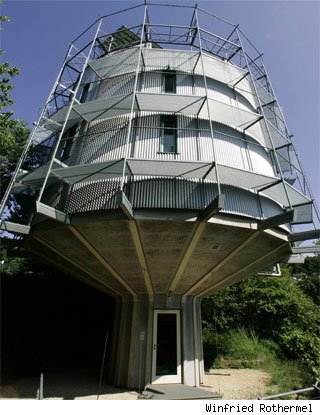
Rotating House – Germany
Architect Rolf Disch was thinking green when he built this structure near Freiburg, Germany. The house rotates with the movement of the sun in winter to save on heating costs. Maybe there’s a renter’s discount if you get dizzy easily?
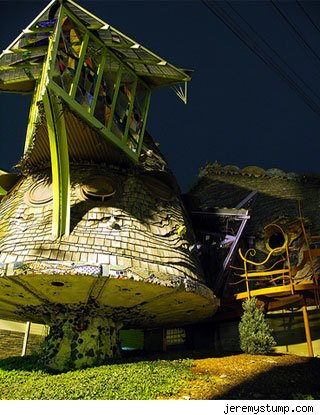
Mushroom House – Ohio
For only $400,000, you could be living in your own fairytale-style mushroom house located in Cincinnati, Ohio.
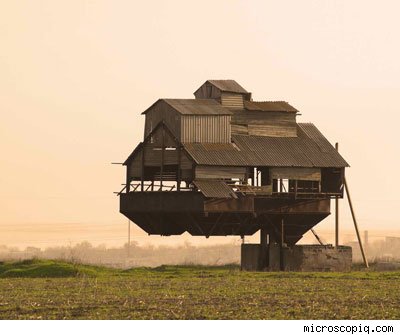
Floating House – Ukraine
Though it seems to defy the laws of nature, this structure in the Ukraine is apparently supported by the beams on the right hand side of the image. It looks a bit fake, don’t you think?
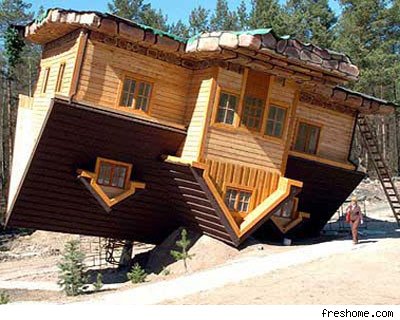
Upside-Down House – Poland
This structure is not a mistake. The upside-down house really was built just as it looks. Designer Daniel Czapiewski created it as a critique of the “upside-down” nature of his country’s former communist government. Located in Szymbark, Poland.
Kamis, 13 Januari 2011
Crooked Houses Around the World
by nate on Sunday, June 6th, 2010 | Attraction, Places to Visit, Travel | No Comments
Here are some of the most wackiest and Strangest houses you will ever see! These houses are all real, if my sources are correct, and most of them you can actually visit and see what it’s like in there.
The Crooked House, Sopot, Poland
This house is situated in Poland and was created by Polish architect Szotyńscy Zaleski.
The Crooked House Of Windsor
The Crooked House of Windsor was build over 300 years ago and it is still sturdy until today. Every year, this house receives over 50,000 visitors annually.
Erwin Wurm: House Attack (Viena, Austria)
Wonderworks (Pigeon Forge, TN, United States)
Cubic Houses (Rotterdam, Netherlands)
The Siden House
On the edge of the Himley Estate lies the The Glynne Arms (more popularly known as the Crooked House or The Siden House). It is a house that has suffered badly from mining subsidence. It lies on what was the divide between Sir Stephen Glynne’s land and that of the Earl of Dudley.
Have a nice day!
diunduh dari : http://www.boncherry.com/
Langganan:
Postingan (Atom)









